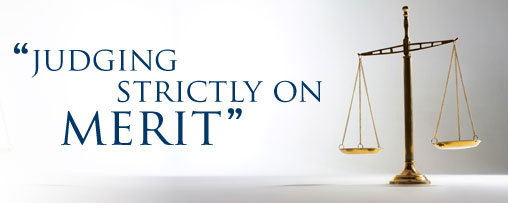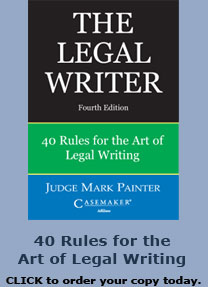Writing tips for e-mail
By Judge Mark P. Painter
E-mail is a wonderful tool. We have instant global communication. Although e-mail was invented in 1971, it didn’t become universal until about 15 years ago. Wow! I remember when I was with a big firm, every big firm had a cable address on its letterhead: Cable: Smithlaw. Being curious, I asked everyone I met in the firm if they had ever sent or received a cable. I never found one.
Cables were the very wrapped wire that ran under the ocean. They were also the conduit for international telephone calls. But cable messages were written, so they could be used as evidence. Phone calls, unless recorded (always legally suspect), were not as useful in proving communication.
Younger people don’t remember when long-distance phone calls were outrageously expensive. Of course, it was a monopoly – Ma Bell charged whatever the regulators would allow. Competition – and technology – have made calling LA from Cincinnati the same as calling locally.
E-mails, once the service is paid for, are free – and instantaneous. But with all new technology, new pitfalls arise. These are just a few hints for making e-mail more useful.
* Always do a re: tell people what’s coming
Using a reference helps others categorize the message’s priority – or its lack. “Next year’s picnic” or “Emergency system shutdown” are different, and the reader will thank you for helping prioritize.
Be specific: If you have different projects going with the same person, be sure to identify the exact category; “your project” or “your e-mail” doesn’t help much. Use a specific reference such as “Your bid on the Ames project.” Then when people search their e-mail, they can easily find the one they are looking for.
* Use real – and plain – English
The language has been dumbed down enough. You isn’t u, and are isn’t r. People weren’t crass enough to use these even with telegrams (anyone remember them?) – when they were paying by the word.
As with all writing, be as brief as possible without losing meaning. But do it with proper grammar and complete sentences.
As lawyers, we know that e-mails are now likely to show up as evidence in lawsuits – bad enough without the embarrassment of poor grammar.
* Always have Spellcheck running
All e-mail programs I know of allow you to set the Spellcheck to automatically check before you send. Make sure it’s on. As with Spellcheck in general, don’t follow it blindly. But it will save you from obvious typos.
* The U.S. Mail still exists
Weeks go by when I do not receive an actual first-class letter, except for bills. We should all remember that an actual letter, on good stationery, with a real stamp, can get someone’s attention. And it’s nostalgic to get one.
* Do you really need a disclaimer on the bottom?
Maybe it makes sense to have the “if you are not the intended recipient” language, but I’m skeptical. Here’s the one our county uses (I’ve tried to have it deleted from mine without success):
This e-mail message, including any attachments, is for the sole use of the intended recipient(s) and may contain private, confidential and/or privileged information. Any unauthorized review, use, disclosure or distribution is prohibited. If you are not the intended recipient, employee or agent responsible for delivering this message, please contact the sender by reply e-mail and destroy all copies of the original e-mail message.
Not especially good grammar, but does it really work?
An Internet site I found recommends this disclaimer:
This email and any files transmitted with it are confidential and intended solely for the use of the individual or entity to whom they are addressed. If you have received this email in error please notify the system manager. This message contains confidential information and is intended only for the individual named. If you are not the named addressee you should not disseminate, distribute or copy this e-mail. Please notify the sender immediately by e-mail if you have received this e-mail by mistake and delete this e-mail from your system. If you are not the intended recipient you are notified that disclosing, copying, distributing or taking any action in reliance on the contents of this information is strictly prohibited.
WARNING: Computer viruses can be transmitted via e-mail. The recipient should check this e-mail and any attachments for the presence of viruses. The company accepts no liability for any damage caused by any virus transmitted by this e-mail. E-mail transmission cannot be guaranteed to be secure or error-free as information could be intercepted, corrupted, lost, destroyed, arrive late or incomplete, or contain viruses. The sender therefore does not accept liability for any errors or omissions in the contents of this message, which arise as a result of e-mail transmission.
No employee or agent is authorized to conclude any binding agreement on behalf of [Company] with another party by email without express written confirmation by [Supervisor or Director].
Our company accepts no liability for the content of this e-mail, or for the consequences of any actions taken on the basis of the information provided, unless that information is subsequently confirmed in writing.
Any views or opinions presented in this e-mail are solely those of the author and do not necessarily represent those of the company. Employees of [Company] are expressly required not to make defamatory statements and not to infringe or authorize any infringement of copyright or any other legal right by e-mail communications. Any such communication is contrary to company policy and outside the scope of the employment of the individual concerned. The company will not accept any liability in respect of such communication, and the employee responsible will be personally liable for any damages or other liability arising.
See www.emaildisclaimers.com.
But if I can’t rely on anything in the e-mail, why send it?
How about this:
“If I sent this to you by mistake, you probably have no interest in the secrets. It would be really nice if you hit “reply” and told me I screwed up, so I could then send the secrets to the person I intended. Then please delete this, as if you wouldn’t anyway. Probably you already deleted it and aren’t reading this.”
This last one was on a website and attributed to one John Sullivan. I tried to locate the particular John Sullivan without success. The site is http://www.goldmark.org/jeff/stupid-disclaimers/fun.html
By sending an e-mail to any of my addresses you are agreeing that:
* I am by definition, “the intended recipient.”
* All information in the e-mail is mine to do with as I see fit and make such financial profit, political mileage, or good joke as it lends itself to.
* I may take the contents as representing the views of your company.
* This overrides any disclaimer or statement of confidentiality that may be included on your message.
____________________________________
Mark Painter has served as a judge on the Ohio First District Court of Appeals for 12 years, after 13 years on the Hamilton County Municipal Court. Judge Painter is the author of 360 nationally published decisions, 115 legal articles, and six books, including The Legal Writer: 40 Rules for the Art of Legal Writing, which is available from http://books.lawyersweekly.com. Judge Painter has given dozens of seminars on legal writing. Contact him through his website, www.judgepainter.org.








